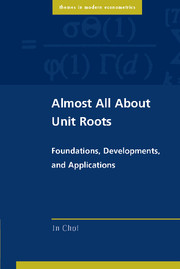Book contents
- Frontmatter
- Dedication
- Contents
- Foreword
- Preface
- Abbreviations and Notation
- 1 Introduction
- 2 Inference on Unit Roots: Basic Methods
- 3 Unit Root Tests under Various Model Specifications
- 4 Alternative Approaches to Inference on Unit Roots
- 5 Other Issues Related to Unit Roots
- 6 Seasonal Unit Roots
- 7 Panel Unit Roots
- Epilogue
- References
- Index
7 - Panel Unit Roots
Published online by Cambridge University Press: 05 May 2015
- Frontmatter
- Dedication
- Contents
- Foreword
- Preface
- Abbreviations and Notation
- 1 Introduction
- 2 Inference on Unit Roots: Basic Methods
- 3 Unit Root Tests under Various Model Specifications
- 4 Alternative Approaches to Inference on Unit Roots
- 5 Other Issues Related to Unit Roots
- 6 Seasonal Unit Roots
- 7 Panel Unit Roots
- Epilogue
- References
- Index
Summary
Introduction
In recent years, there has been much interest in nonstationary panels at both the theoretical and empirical levels. Today in macroeconomics, international finance, and other areas it is quite common to use panel data rather than individual time series, probably because of the developments of econometric tools for nonstationary panels. The initial, main motivation for using panel data was to increase the power of unit root tests because univariate unit root tests have low power as discussed briefly in Subsection 2.3.4. Indeed, Levin and Lin's (1992) and subsequent panel unit root tests demonstrate by simulation the power advantage of using panel data.
The literature on nonstationary panels that began from the power consideration has developed beyond that motivation and brought up some challenging issues that could not be conceived in univariate testing. In conventional panel data analysis, cross-sectional units are assumed to be independent, a reason- able approximation to reality. In using macropanels, however, independence is an obviously unrealistic assumption, and much effort has been expended to cope with this challenge. New, useful tools have emerged along the way, which will also help conventional, micropanel data analysis when the assumption of independence is deemed to be inappropriate. Moreover, in nonstationary panels, there is the possibility of cross-sectional cointegration, which complicates inferential procedures considerably. Some procedures have been developed to deal with this situation, but none is totally successful in my opinion.
The developments of the literature on panel unit roots resemble those of univariate, nonstationary time series that we have seen in Chapter 2. From reading Chapter 2, one may realize that the research paradigm for nonstationary panels is similar to that for univariate nonstationary time series. However, the literature on panel unit roots is still much thinner than that on univariate unit roots. Whether the panel literature will become as mature as that on univariate unit roots in the future remains to be seen.
- Type
- Chapter
- Information
- Almost All about Unit RootsFoundations, Developments, and Applications, pp. 191 - 222Publisher: Cambridge University PressPrint publication year: 2015

